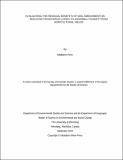| dc.identifier.citation | Perry, Madelynn. Evaluating the Residual Benefits of Soil Amendments in Reducing Phosphorus Losses to Snowmelt Runoff from Agricultural Fields; A thesis submitted to the faculty of Graduate Studies in partial fulfillment of the degree requirements for the ... Master of Science in Environmental and Social Change, The University of Winnipeg. Winnipeg, Manitoba, Canada: The University of Winnipeg, September 2023. DOI: 10.36939/ir.202311141142. | en_US |
| dc.description.abstract | Phosphorus (P) in snowmelt runoff from agricultural fields across the Canadian prairies is a major source of nutrient pollution to freshwater bodies, such as Lake Winnipeg. The use of soil amendments, such as alum (Al2(SO4)318H2O), gypsum (CaSO4·2H2O), and magnesium-sulphate (MgSO4) have previously shown to reduce P losses from soils with snowmelt in the field, and under simulated snowmelt flooding in the laboratory through converting P to less soluble forms; however, their long-term effectiveness has not been investigated. This thesis examined the effectiveness of alum, gypsum, and magnesium- sulphate after 12 - 18 months after amendment application in (a) reducing dissolved reactive P (DRP) loss with snowmelt runoff in field plots, (b) reducing DRP concentrations in floodwater of intact soil columns with simulated snowmelt flooding, and (c) reducing potential P mobility through changes to P fractions and speciation. Amendments were applied in the fall of 2020 at a rate of 2.5 Mg ha-1 in plots arranged in a randomized complete block design, consisting of 4 replicates of 4 amendments (alum, gypsum, magnesium sulphate, and unamended) for a total of 16 field plots. During the snowmelt period, concentrations of DRP and cations, as well as pH in snowmelt were determined. Using intact soil columns taken from the same field plots, a more controlled laboratory study was conducted, where soil columns were flooded and incubated at 4°C to simulate snowmelt conditions. Porewater and floodwater samples were extracted weekly and analyzed for DRP, cation concentrations, pH, and soil redox potential. Phosphorus species in porewater were predicted using Visual MINTEQ 3.1. on days 0, 28 and 49 during the laboratory study. Phosphorus fractions were also determined using a modified sequential fractionation method. In the field, snowmelt DRP concentrations increased over the sampling period regardless of amendment, with higher concentrations seen after the soil had thawed. In the latter days of sampling, the alum, gypsum, and magnesium sulphate-amendments decreased DRP concentrations in snowmelt by 9 –31% relative to the control. However, differences between treatments and the control were not statistically significant. Snowmelt DRP loads (calculated using DRP concentrations and snowmelt volume) showed a significant positive relationship with snowmelt volume, whereas the relationship with DRP concentration was not significant. During the laboratory study, redox potential in all treatments decreased with time of flooding. Soil columns taken from alum-amended field plots had significantly lower DRP concentrations in porewater when compared to all other treatments, but this effect was not observed for floodwater. Predicted P species showed slight changes in alum-amended soils, suggesting the potential for alum to delay the reductive dissolution of ferric phosphate (strengite, FePO4·2H2O), thereby delaying the P release. However, P fractionation analysis did not show significant differences in soil P fractions between treatments. The results of this research suggest that the effectiveness of these amendments in reducing P loss to snowmelt is very small to negligible one year after application, or after one snowmelt flooding event. This implies that re-application of amendments on a more frequent basis or application at a higher rate may be necessary for amendments to be effective in reducing P loss to snowmelt. However, more field scale research is necessary to provide recommendations to farmers regarding the use of soil amendments for this purpose. | en_US |

